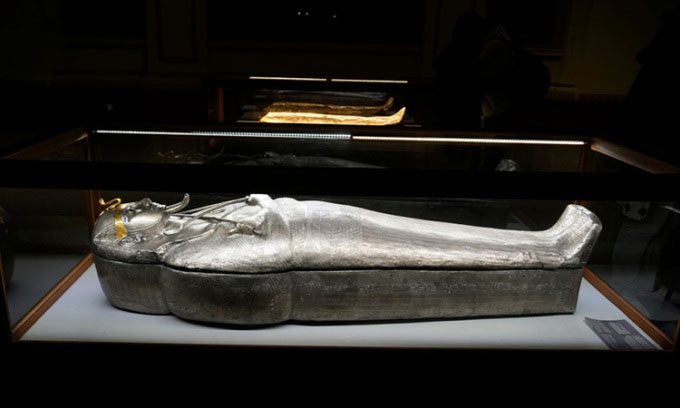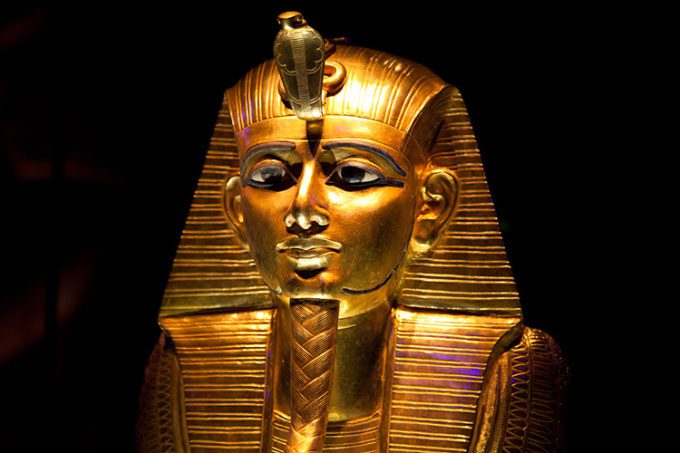The silver coffin, a material more valuable than gold due to its necessity for importation, serves as evidence of the power and wealth of Pharaoh Psusennes I.
In 1940, amidst the chaos of World War II in Western Europe, French archaeologist Pierre Montet unearthed an impressive treasure at Tanis, Egypt. This discovery holds significance comparable to that of archaeologist Howard Carter’s finding of the intact tomb of the famous Pharaoh Tutankhamun about two decades earlier. However, despite its immense importance, news of this new discovery failed to create a stir in European society as people were primarily focused on World War II.

The silver coffin of Pharaoh Psusennes I displayed at the Egyptian Museum in Cairo on February 20, 2023. (Photo: AP/Amr Nabil).
The tomb discovered by Montet belongs to Psusennes I, a lesser-known pharaoh of the 21st Dynasty of ancient Egypt. Psusennes I was the third king of the 21st Dynasty, ascending to power at the beginning of the Third Intermediate Period of Egypt, a politically tumultuous era.
During this time, the monarchy was fragmented, and the country was divided into Upper and Lower Egypt. The pharaohs of the 21st Dynasty ruled from the city of Tanis, their influence primarily confined to the Lower Egyptian plains. Meanwhile, Thebes served as the stronghold of the High Priest of Amun, who governed Upper Egypt.
Experts previously believed that the pharaohs of the 21st Dynasty held limited power. However, the discovery of Psusennes I’s tomb altered this perception. The most remarkable find within the tomb was a solid silver coffin, earning Psusennes I the title of the Silver Pharaoh.
In ancient Egyptian culture, gold was considered the flesh of the gods, while silver represented their bones. Gold was more abundant in ancient Egypt, but silver was even more valuable as it had to be imported from Western Asia and the Mediterranean.
Consequently, the solid silver coffin found in Psusennes I’s tomb is evidence of his immense wealth and power. Additionally, the craftsmanship of the metal objects within the tomb, including the silver coffin, indicates that Psusennes I also controlled the necessary workforce to create such luxurious items.
The silver coffin, shaped like a human, was placed inside a pink granite sarcophagus, which was in turn housed within a granite coffin (a type of sarcophagus). Interestingly, the granite coffin once belonged to Pharaoh Merenptah of the 19th Dynasty, who succeeded Ramesses II.

The gold mask of Pharaoh Psusennes I. (Photo: Dave Nakayama).
The mummy of Psusennes I did not survive the test of time. Instead of a complete body, Montet found only fragments of bones, black dust, and numerous funerary items, such as a board depicting the gold-plated mummy and a solid gold mask that may have covered the pharaoh’s face.
The damage to Psusennes I’s mummy is not unusual given the burial environment of this pharaoh. Unlike the arid, desert-like conditions of the “Valley of the Kings” in Luxor, much of Lower Egypt consists of moist and marshy land. The city of Tanis is no exception.
Water seeped through the ground, causing damage to Psusennes I’s mummy, and most wooden items also deteriorated over time. However, Montet was able to recover some durable items, such as canopic jars, small shabti figures, and valuable objects from the coffin. These treasures are even believed to rival those of Tutankhamun.
Psusennes I was wealthy and held considerable power, having ruled for a lengthy period of 41 or 46 years (approximately 1047 – 1001 BC). Some Egyptologists even suggest that Psusennes I reigned for up to 51 years. To have maintained power during such a politically unstable time, his reign is indeed impressive.





















































